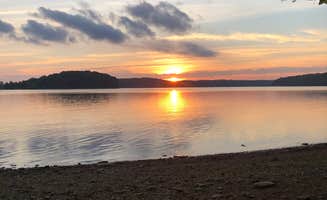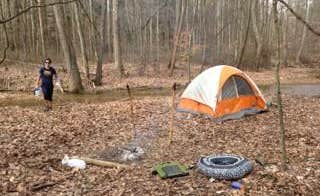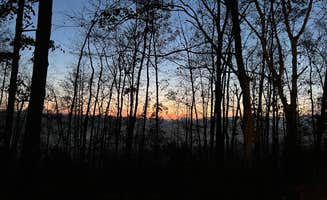Dispersed camping near French Lick, Indiana offers primitive sites throughout the Hoosier National Forest with elevations ranging from 400 to 900 feet. The region features limestone formations and mixed hardwood forests dominated by oak, hickory, and maple trees. Summer temperatures typically reach 85-90°F with high humidity, while spring and fall camping provides more moderate conditions between 50-70°F.
What to do
Hiking opportunities: Peninsula Trail provides access to Lake Monroe with multiple backcountry campsites. "There are designated camping sites found in the forest maps," notes Angela A., while Aspen B. adds that "Campsite #18 has a great view and is large enough for at least 4 tents if you have a big group."
Wildlife observation: Keep your eyes open for native wildlife in the Hickory Ridge Primitive Dispersed Campsites. According to campers, the area provides excellent wildlife viewing opportunities. Elliot F. from another nearby site recommends to "watch for timber rattlesnakes" in the valleys, as they're native to the region.
Fossil hunting: The limestone areas throughout Hoosier National Forest contain numerous fossils. As one hiker noted about the region, trails have "lovely vistas and lots of fossils on the trail and creek beds." Creek beds after rain often expose new specimens for amateur collectors.
Creek exploration: Visit Mitchell Creek Road Dispersed where you can explore the waterway. "There are rock outcroppings along this road, which follows Mitchell Creek and lots to explore on foot," says Jaymi A., while Sabrina C. notes the site "has a creek and is flat enough for a tent."
What campers like
Genuine seclusion: Berry Ridge Road - Dispersed Camping provides truly private camping experiences. Amber R. describes it as a "beautiful secluded site that is pretty far off of the road, but not too far. There was no traffic or other people in site." Jacob adds that campsites are "sometimes half mile or more apart."
Night sky viewing: The minimal light pollution makes stargazing exceptional. Matt V. notes that "light pollution is pretty low however, so good stargazing" at some of the more remote sites. During new moon phases, the Milky Way is often visible.
Four-season camping: Unlike many state parks, these dispersed areas remain open year-round. Jimmy H. reports, "I pulled in at midnight in a sedan in the winter and I was able to safely find my way. Very nice drive during the day, hiking is fantastic!"
Quiet surroundings: The remote nature provides unusual quiet. At one site, a camper reported that "only two vehicles passed during the entire 16 hours. VERY quiet." David S. describes Berry Ridge Road as "a hidden gem. Just a few sites along the road minimum traffic encountered."
What you should know
Navigation challenges: Paper maps are essential in many areas. "Have a paper map handy, as there is no cell signal and GPS was spotty," advises one camper. Forest roads can be confusing with limited signage.
Road conditions: Most access roads are unpaved and can become problematic. Sofia A. warns about "the very skinny gravel road" to Mitchell Creek, while Palynn F. notes about Berry Ridge, "I would not bring a RV here especially after rain."
Water sources: Seasonal availability varies dramatically. "Water can become scarce in the summer/fall months, but if you walk far enough, you're likely to come by a stream of some sort," advises Dave E. from Knobstone Trail.
Wildlife encounters: Be prepared for nocturnal visitors. Reuben R. shares that "every night at around 5pm I would hear rustling in the leaves, I assumed it was a pack of cayotes and they would leave once I started banging on stuff." Multiple campers report hearing coyotes at night.
Tips for camping with families
Choose drive-up sites: With children, select sites with vehicle access. Jeremy F. notes about Berry Ridge Road that "multiple campsites in the area, I've stayed at two both of which were away from others, clean, fairly flat and had plenty of dead wood around to burn."
Pack extra water: No reliable water sources exist at most sites. Matt V. advises there's a "long walk to the water so make sure you bring plenty of drinking water. Springs available in the valleys" but these shouldn't be your primary source.
Consider education opportunities: The forests provide natural learning experiences. Jase G. from Hickory Ridge recommends the area for "some good quality time with the family while being plugged into nature and unplugged from their electronics."
Research site access: Some locations require significant hiking. Logan from Jackson Trailhead notes "there's parking after a decrepit gravel road and suitable for camping. There are campsites along the trail just have to find them."
Tips from RVers
Vehicle size limitations: Most dispersed sites accommodate only small rigs. One camper noted, "I did not see any pull offs that would accommodate an RV of any size, and nothing large enough to turn a trailer around."
Clearance requirements: High-clearance vehicles are recommended for many access roads. At Horse Camp Rd Dispersed, the terrain requires careful navigation, though reviewers note it's "a cool place" for those with appropriate vehicles.
Site selection strategy: Scout locations before committing. Brian S. shares about Berry Ridge Road: "The main spot was full but I found a great pull off spot a lil further. I came across at least 5 lil spots."
Seasonal timing: Spring access can be problematic after rain. Multiple reviewers mention muddy or washed-out conditions that make roads impassable for larger vehicles during wet periods.




